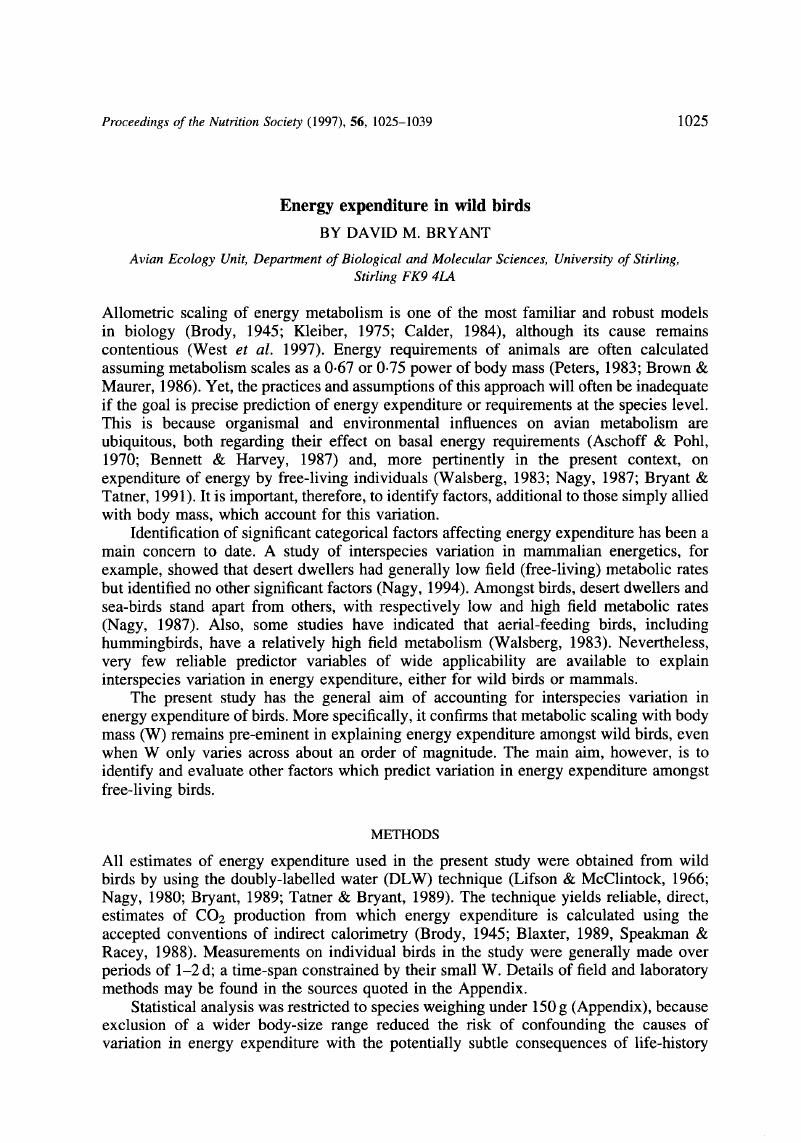Crossref Citations
This article has been cited by the following publications. This list is generated based on data provided by Crossref.
Speakman, John
1997.
Factors influencing the daily energy expenditure of small mammals.
Proceedings of the Nutrition Society,
Vol. 56,
Issue. 3,
p.
1119.
Bryan, S. M.
and
Bryant, D. M.
1999.
Heating nest–boxes reveals an energetic contraint on incubation behaviour in great tits, Parus major.
Proceedings of the Royal Society of London. Series B: Biological Sciences,
Vol. 266,
Issue. 1415,
p.
157.
Nagy, K. A.
Girard, I. A.
and
Brown, T. K.
1999.
ENERGETICS OF FREE-RANGING MAMMALS, REPTILES, AND BIRDS.
Annual Review of Nutrition,
Vol. 19,
Issue. 1,
p.
247.
Speakman, J.R.
1999.
Advances in Ecological Research Volume 30.
Vol. 30,
Issue. ,
p.
177.
Harper, E.J.
and
Turner, C.L.
2000.
Nutrition and energetics of the canary (Serinus canarius).
Comparative Biochemistry and Physiology Part B: Biochemistry and Molecular Biology,
Vol. 126,
Issue. 3,
p.
271.
Williams, Tony D.
and
Vézina, François
2001.
Current Ornithology, Volume 16.
p.
355.
Thomas, Donald W.
Blondel, Jacques
Perret, Philippe
Lambrechts, Marcel M.
and
Speakman, John R.
2001.
Energetic and Fitness Costs of Mismatching Resource Supply and Demand in Seasonally Breeding Birds.
Science,
Vol. 291,
Issue. 5513,
p.
2598.
Ward, S.
Möller, U.
Rayner, J. M. V.
Jackson, D. M.
Bilo, D.
Nachtigall, W.
and
Speakman, J. R.
2001.
Metabolic power, mechanical power and efficiency during wind tunnel flight by the European starlingSturnus vulgaris.
Journal of Experimental Biology,
Vol. 204,
Issue. 19,
p.
3311.
Fyhn, Marianne
Gabrielsen, Geir W.
Nordøy, Erling S.
Moe, Børge
Langseth, Ingveig
and
Bech, Claus
2001.
Individual Variation in Field Metabolic Rate of Kittiwakes (Rissa tridactyla) during the Chick‐Rearing Period.
Physiological and Biochemical Zoology,
Vol. 74,
Issue. 3,
p.
343.
Spencer, K. A.
and
Bryant, D. M.
2002.
State–dependent behaviour in breeding barn swallows (
Hirundo rustica
): consequences for reproductive effort
.
Proceedings of the Royal Society of London. Series B: Biological Sciences,
Vol. 269,
Issue. 1489,
p.
403.
Jodice, Patrick GR
Roby, Daniel D
Hatch, Scott A
Gill, Verena A
Lanctot, Richard B
and
Visser, G Henk
2002.
Does food availability affect energy expenditure rates of nesting seabirds? A supplemental-feeding experiment with Black-legged Kittiwakes (Rissa tridactyla).
Canadian Journal of Zoology,
Vol. 80,
Issue. 2,
p.
214.
Scheiffarth, Gregor
Wahls, Svea
Ketzenberg, Christiane
and
Exo, Klaus‐Michael
2002.
Spring migration strategies of two populations of bar‐tailed godwits, Limosa lapponica, in the Wadden Sea: time minimizers or energy minimizers?.
Oikos,
Vol. 96,
Issue. 2,
p.
346.
Ward, S.
Bishop, C. M.
Woakes, A. J.
and
Butler, P. J.
2002.
Heart rate and the rate of oxygen consumption of flying and walking barnacle geese (Branta leucopsis) and bar-headed geese (Anser indicus).
Journal of Experimental Biology,
Vol. 205,
Issue. 21,
p.
3347.
Schleucher, Elke
2002.
Metabolism, body temperature and thermal conductance of fruit-doves (Aves: Columbidae, Treroninae).
Comparative Biochemistry and Physiology Part A: Molecular & Integrative Physiology,
Vol. 131,
Issue. 2,
p.
417.
Weathers, Wesley W.
Davidson, Charisse L.
Olson, Christopher R.
Morton, Martin L.
Nur, Nadav
and
Famula, Thomas R.
2002.
Altitudinal variation in parental energy expenditure by white-crowned sparrows.
Journal of Experimental Biology,
Vol. 205,
Issue. 18,
p.
2915.
Jodice, P. G. R.
Roby, D. D.
Suryan, R. M.
Irons, D. B.
Kaufman, A. M.
Turco, K. R.
and
Visser, G. H.
2003.
Variation in Energy Expenditure among Black‐Legged Kittiwakes: Effects of Activity‐Specific Metabolic Rates and Activity Budgets.
Physiological and Biochemical Zoology,
Vol. 76,
Issue. 3,
p.
375.
Livezey, Bradley C.
2003.
Evolution of Flightlessness in Rails (Gruiformes: Rallidae): Phylogenetic, Ecomorphological, and Ontogenetic Perspectives.
Ornithological Monographs,
p.
iii.
Godfrey, Jason D.
Bryant, David M.
and
Williams, Murray J.
2003.
Radio-telemetry increases free-living energy costs in the endangered Takahe Porphyrio mantelli.
Biological Conservation,
Vol. 114,
Issue. 1,
p.
35.
POONSWAD, Pilai
TSUJI, Atsuo
and
JIRAWATKAVI, Narong
2004.
Estimation of nutrients delivered to nest inmates by four sympatric species of hornbills in Khao Yai National Park, Thailand.
ORNITHOLOGICAL SCIENCE,
Vol. 3,
Issue. 2,
p.
99.
Pendlebury, C. J.
MacLeod, M. G.
and
Bryant, D. M.
2004.
Variation in temperature increases the cost of living in birds.
Journal of Experimental Biology,
Vol. 207,
Issue. 12,
p.
2065.





